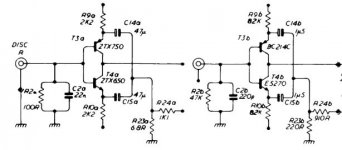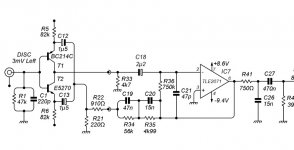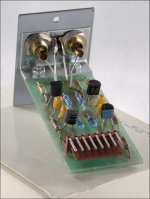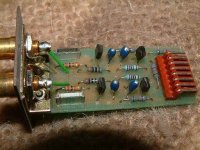Hi,
My friend has removed the MC module from his Quad 34 pre-amp to mail to me to convert it to MM, now that he has sadly inherited an old Rega Planar 3 along with his dad's record collection.
The removable board is only the loading and gain stage of the phono amp, the rest of the phono amp remains inside the amp.
The MC and MM boards have the same parts count and locations, just different values, so I want to confirm what I should use before buying parts because the transistors are obsolete and the cartridge loading at 220pF is inappropriate for the AT cartridge being used.
There are schematics attached. One shows the MC and MM versions, and the other shows the whole phono stage with the MM circuit. As I will be given the MC module there are no parts on it that I can re-use.
PNP transistor - BC214C, propose BC559C (or BC560C?) instead
NPN transistor - BC413C is usually fitted, propose BC549C (or BC550C?) instead
Load cap - 220pF, propose 47pF instead. Arm is RB300 with original wiring (100pF-ish) and cartridge is AT-VM95E. I think a ceramic is OK here (COG).
1.5uF tants - I'm not sure whether using a different type of cap here might affect stability in anyway, so should probably stick with tantalums.
I don't think I need to deviate from the MM schematic regarding resistor values, even with the transistor subsitutions, but please correct me if I'm wrong.
Any advice welcomed.
Thanks,
Glenn
My friend has removed the MC module from his Quad 34 pre-amp to mail to me to convert it to MM, now that he has sadly inherited an old Rega Planar 3 along with his dad's record collection.
The removable board is only the loading and gain stage of the phono amp, the rest of the phono amp remains inside the amp.
The MC and MM boards have the same parts count and locations, just different values, so I want to confirm what I should use before buying parts because the transistors are obsolete and the cartridge loading at 220pF is inappropriate for the AT cartridge being used.
There are schematics attached. One shows the MC and MM versions, and the other shows the whole phono stage with the MM circuit. As I will be given the MC module there are no parts on it that I can re-use.
PNP transistor - BC214C, propose BC559C (or BC560C?) instead
NPN transistor - BC413C is usually fitted, propose BC549C (or BC550C?) instead
Load cap - 220pF, propose 47pF instead. Arm is RB300 with original wiring (100pF-ish) and cartridge is AT-VM95E. I think a ceramic is OK here (COG).
1.5uF tants - I'm not sure whether using a different type of cap here might affect stability in anyway, so should probably stick with tantalums.
I don't think I need to deviate from the MM schematic regarding resistor values, even with the transistor subsitutions, but please correct me if I'm wrong.
Any advice welcomed.
Thanks,
Glenn
Attachments
Last edited:
Yes Marcel is right,the BC 214C was the old low noise equivalent of the more modern BC560C which has slightly more gain.
220pf/47k is or was the standard value of input components for a MM cartridge ( although this can be varied--the capacitance to suite ) .
If its an old AT cartridge I could look up the capacitance in a book I have.
Tantalums don't usually deteriorate like electrolytics and should still be good.
Yes use COG --ONLY they have a cut -off value above which would not be used in audio , I think its just above your value otherwise as JLH says use polystyrene --I do.
Most AT cartridges I know are MC what is yours ?
I too have a very early edition of the RB300--still using it .
220pf/47k is or was the standard value of input components for a MM cartridge ( although this can be varied--the capacitance to suite ) .
If its an old AT cartridge I could look up the capacitance in a book I have.
Tantalums don't usually deteriorate like electrolytics and should still be good.
Yes use COG --ONLY they have a cut -off value above which would not be used in audio , I think its just above your value otherwise as JLH says use polystyrene --I do.
Most AT cartridges I know are MC what is yours ?
I too have a very early edition of the RB300--still using it .
Thanks - no, it's MM, a new AT-VM95E with recommended load capacitance 100pF-200pF total. As there is probably about 100pF in the arm wiring I think 47pF on the module is a safe bet.
I can't use ANY of the existing components because the board is an MC board and all values are different so all components will have to be removed. I will need to buy a full set of components, including new tantalums, the BC550C/BC560C, the 47pF and all resistors.
Below are photos of both versions. The MM one has 220pF ceramic capacitors that look like resistors. The one with the stacked film caps (22nF) is the MC one.
I can't use ANY of the existing components because the board is an MC board and all values are different so all components will have to be removed. I will need to buy a full set of components, including new tantalums, the BC550C/BC560C, the 47pF and all resistors.
Below are photos of both versions. The MM one has 220pF ceramic capacitors that look like resistors. The one with the stacked film caps (22nF) is the MC one.
Attachments
Not so keen on those stacked film capacitors they come away from the ends pretty easily and too much heat from a soldering iron and they fall apart and melt .
Buy low noise metal resistors ( or better ) as this is a sensitive input position , personally I would replace all the capacitors with polystyrene but D.Self likes COG whereas I am a JLH man.
Low ceramic ( COG ) goes up to 330pf after that there is a big difference in the value of "D" and stability , keep with tantalums and I also spend as much money on the input as I do on the output active devices I buy---buy quality it does make a difference.
Buy low noise metal resistors ( or better ) as this is a sensitive input position , personally I would replace all the capacitors with polystyrene but D.Self likes COG whereas I am a JLH man.
Low ceramic ( COG ) goes up to 330pf after that there is a big difference in the value of "D" and stability , keep with tantalums and I also spend as much money on the input as I do on the output active devices I buy---buy quality it does make a difference.
Low ceramic ( COG ) goes up to 330pf after that there is a big difference in the value of "D" and stability
As far as I know, 100 nF C0G / NP0 capacitors are as good as 100 pF C0G / NP0 capacitors, but until the invention of the multilayer capacitor, 100 nF NP0 capacitors simply didn't exist. Back then, all ceramic capacitors above a few hundreds of pF were made with X7R, Z5U or other lossy and nonlinear class 2 dielectrics.
Didn't know you could get --100nf -COG Marcel ?--we are talking LOW-K right ?
There is medium -K but there is a big difference between the two , that type of multilayer capacitor didn't like being handled/soldered too much the ends came off along with the legs .
I will check up maybe my capacitor book is well out of date to see if larger values of COG are available.
There is medium -K but there is a big difference between the two , that type of multilayer capacitor didn't like being handled/soldered too much the ends came off along with the legs .
I will check up maybe my capacitor book is well out of date to see if larger values of COG are available.
Last time I checked the Mouser website, 470 nF was the largest value you could get as SMD multilayer ceramic capacitor. If this link works, it links to a 100 nF capacitor:
https://eu.mouser.com/ProductDetail...GAEpiMZZMukHu%2BjC5l7YWY0Wy3FSR3VzSPlGPDEO0Q=
https://eu.mouser.com/ProductDetail...GAEpiMZZMukHu%2BjC5l7YWY0Wy3FSR3VzSPlGPDEO0Q=
They also make them as through-hole caps, for example:
https://eu.mouser.com/ProductDetail/TDK/FA26C0G2A104JRU06?qs=rrS6PyfT74cTUsU8qtT1pQ==
https://eu.mouser.com/ProductDetail/TDK/FA26C0G2A104JRU06?qs=rrS6PyfT74cTUsU8qtT1pQ==
I see both BC550C and BC560C there today. Higher gain and lower nouse than BC549/559.Thanks.
Looking at Farnell there are no BC560C available anymore, so it will have to be BC559C (and BC549C) which I believe are the same specs except lower voltage (still high enough though).
EJP
On the UK version it says--( in red ) --"no longer manufactured " under Availability -
https://uk.farnell.com/w/c/semiconductors-ics/prl/results?st=bc560c
https://uk.farnell.com/w/c/semiconductors-ics/prl/results?st=bc560c
Yes Ejp as you say "tens of 1000,s" are in stock in various places like Cricklewood (UK) BUT they are not 100 % genuine original specifications of the the original MULLARD versions .
BC560C is listed as "low noise " and the "low noise " quoted is FOUR DB while the original MULLARD versions are ==TWO DB --obviously not manufactured to the same standard .
My old Mullard book ( industrial version ) quotes =2db .
At 4db you would be as well buying other equivalents as they are plentiful
BC560C is listed as "low noise " and the "low noise " quoted is FOUR DB while the original MULLARD versions are ==TWO DB --obviously not manufactured to the same standard .
My old Mullard book ( industrial version ) quotes =2db .
At 4db you would be as well buying other equivalents as they are plentiful
But the supplier is ON in many so standards have slipped in manufacturing .
Its like very expensive NOS /original manufacture tubes-- in copying them they sell cheap versions that wouldn't make it through the production line of a big factory like Mullard/Mazda/Osram etc that used to exist in England .
I have seen the quality control in them and in those days it was very high not for a minute do I think modern cheap versions are made to the same quality standard .
Its like very expensive NOS /original manufacture tubes-- in copying them they sell cheap versions that wouldn't make it through the production line of a big factory like Mullard/Mazda/Osram etc that used to exist in England .
I have seen the quality control in them and in those days it was very high not for a minute do I think modern cheap versions are made to the same quality standard .
for low source impedances like MM transistors with a low base resistance are needed as that is becoming dominant in then noise. that is why you either see many transistors paralelled or RF transistors being used. Some medium power low Vsat transistors could have these properties. the base resistance is not always properly modeled in the spice models. rule of thumbLpNp transistors have N material in the base with higher conductivity, hence lower base resistance.
the higher the HFE the thinner the base, the higher the base resistance.
the higher the HFE the thinner the base, the higher the base resistance.
- Home
- Source & Line
- Analogue Source
- QUAD 34 phono MC to MM conversion



